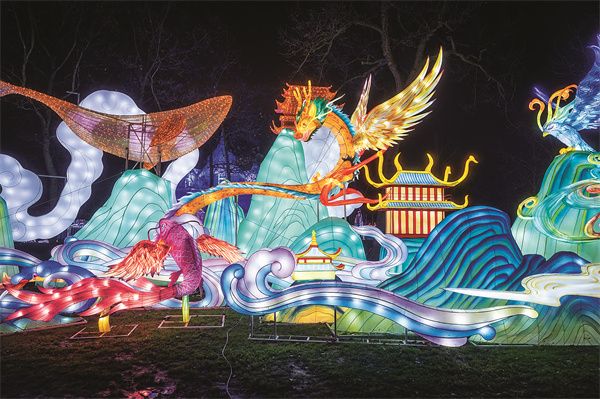
Mythical creatures described in Shan Hai Jing (Classic of Mountains and Seas), an ancient work of Chinese literature, are recreated at the Yuyuan Garden Lantern Show in Paris.[Photo provided to China Daily]
We will soon enter the Year of the Dragon. Or should that be the Year of the Loong? That is a question that has been a subject for debate in China, as some say there is a difference between the two in Chinese and Western mythology.
They point to dragons in the West being usually depicted as malevolent, fire-breathing creatures that hoard treasure and terrorize villages. Dragons they say are typically seen as symbols of chaos and evil, portrayed as antagonists in Western mythology and literature, and often depicted as malevolent adversaries to be vanquished by valiant heroes. These depictions hark back to the archetypal myths of the ancient Mesopotamian and Near Eastern cultures, in which dragon-like creatures, such as Tiamat in Mesopotamian mythology are forces of chaos and destruction that are confronted and ultimately defeated in a great battle.
Such symbolic resonance can be seen in the enduring appeal of dragons in Western popular culture today where they are staples of fantasy literature, films, video games, and TV shows, often embodying a mix of awe-inspiring and fearsome qualities that put them at the heart of struggles between good and evil.
In Chinese culture, loong are revered as symbols of power, excellence, and good luck, and they are often depicted as wise and kind creatures.
The loong has been a central motif in Chinese culture for thousands of years, and its origins can be traced back to early Chinese civilization through mythology, folklore and religious beliefs. Since loong were believed to have control over natural phenomena such as rain, storms and water, and were associated with the life-giving properties of water and the fertility of the land, loong became symbols of strength and good fortune, and they became associated with balance, harmony and the natural order of the universe.
Representing auspiciousness, vitality and the power of nature, loong remain a revered and beloved symbol in Chinese society, reflecting the enduring significance of historical traditions in modern China.
The differences in perception of the mythical creatures in China and the West are rooted in their different cultural values.
Thus the answer to the question at the beginning is clear: Whether or not to use loong instead of dragon is not important. What is important is that as we enter a new lunar year people globally appreciate the cultural values embodied in such Chinese symbols as loong.
By ZHANG ZHOUXIANG | China Daily





